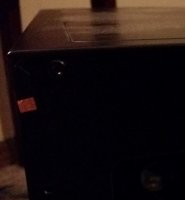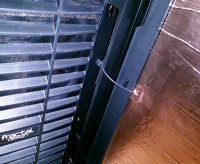Long ago, it was safe to assume the entirety of a case would be shielded (skeleton and shell). At some point, I stopped thinking about it, and only now did it dawn on me that my plastic and anodized aluminum case is only shielded on the back, bottom panel, and the mainboard tray. This does me no good as EMI leaks out the sides and front with impunity. This is a mess in a studio setup. The case is a CM HAF X which I'm otherwise happy with.
I need a similar full-size ATX case... Casters would be nice, but more importantly, it needs to be shielded. I will soon go from a modest home studio to a proper home studio so this is important to me for recording purposes. Manufacturers, in my experience, never talk about having fully grounded chassis plus side panels, front grilles, etc. Maybe they do for server cases, but that's not what I'm looking for.
I scraped off some of the anodized covering from the back of the case, added an alligator clip to it and now have a large sheet of aluminum foil attached to it by wire draped across the front. A terrible solution as it hampers intake, looks awful, and the cats love playing with it...
Shielding can be achieved with a Faraday cage--it need not be a sealed box, so small gaps are fine considering the wavelengths we're concerned about. This is why a fan grille is still compatible with becoming a part of a functional shield, assuming it's attached to ground which none of mine are.
Could anyone help me out by taking a multimeter to their cases and seeing how well-grounded the exterior elements are? You know you're curious! That would include checking things like front intake fan grilles, expansion bay grilles, removal side panels, etc. The easiest way to test is to unplug your PC from the wall and touch the ground plug of the AC cable to one probe of your multimeter and another to the part of the case you're testing for continuity. Make sure the PSU's switch is in ON mode for your tests. The meter should be set to the Ohm sign. Once you confirm one place has continuity with ground (like a screw attaching the PSU to the back of the case), you can go ahead and plug the PC back into the wall for the remainder of your tests assuming you are careful.
I'd really appreciate knowing if convenient options are available out there, or if I'm going to have a buy an all-metal case and then scrape, solder, clamp, and tape my own solution.
I need a similar full-size ATX case... Casters would be nice, but more importantly, it needs to be shielded. I will soon go from a modest home studio to a proper home studio so this is important to me for recording purposes. Manufacturers, in my experience, never talk about having fully grounded chassis plus side panels, front grilles, etc. Maybe they do for server cases, but that's not what I'm looking for.
I scraped off some of the anodized covering from the back of the case, added an alligator clip to it and now have a large sheet of aluminum foil attached to it by wire draped across the front. A terrible solution as it hampers intake, looks awful, and the cats love playing with it...
Shielding can be achieved with a Faraday cage--it need not be a sealed box, so small gaps are fine considering the wavelengths we're concerned about. This is why a fan grille is still compatible with becoming a part of a functional shield, assuming it's attached to ground which none of mine are.
Could anyone help me out by taking a multimeter to their cases and seeing how well-grounded the exterior elements are? You know you're curious! That would include checking things like front intake fan grilles, expansion bay grilles, removal side panels, etc. The easiest way to test is to unplug your PC from the wall and touch the ground plug of the AC cable to one probe of your multimeter and another to the part of the case you're testing for continuity. Make sure the PSU's switch is in ON mode for your tests. The meter should be set to the Ohm sign. Once you confirm one place has continuity with ground (like a screw attaching the PSU to the back of the case), you can go ahead and plug the PC back into the wall for the remainder of your tests assuming you are careful.
I'd really appreciate knowing if convenient options are available out there, or if I'm going to have a buy an all-metal case and then scrape, solder, clamp, and tape my own solution.
Last edited:
![[H]ard|Forum](/styles/hardforum/xenforo/logo_dark.png)

